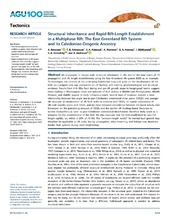Structural inheritance and rapid rift-length establishment in a multiphase rift: The East Greenland rift system and its Caledonian orogenic ancestry
Rotevatn, Atle; Kristensen, Thomas Berg; Ksienzyk, Anna Katharina; Wemmer, Klaus; Henstra, Gijs Allard; Midtkandal, Ivar; Grundvåg, Sten-Andreas; Andresen, Arild
Peer reviewed, Journal article
Published version

Åpne
Permanent lenke
https://hdl.handle.net/1956/20234Utgivelsesdato
2018-06Metadata
Vis full innførselSamlinger
- Department of Earth Science [1050]
Originalversjon
https://doi.org/10.1029/2018tc005018Sammendrag
We investigate (i) margin‐scale structural inheritance in rifts and (ii) the time scales of rift propagation and rift length establishment, using the East Greenland rift system (EGR) as an example. To investigate the controls of the underlying Caledonian structural grain on the development of the EGR, we juxtapose new age constraints on rift faulting with existing geochronological and structural evidence. Results from K‐Ar illite fault dating and syn‐rift growth strata in hangingwall basins suggest initial faulting in Mississippian times and episodes of fault activity in Middle‐Late Pennsylvanian, Middle Permian, and Middle Jurassic to Early Cretaceous times. Several lines of evidence indicate a close relationship between low‐angle late‐to‐post‐Caledonian extensional shear zones (CESZs) and younger rift structure: (i) reorientation of rift fault strike to conform with CESZs, (ii) spatial coincidence of rift‐scale transfer zones with CESZs, and (iii) close temporal coincidence between the latest activity (late Devonian) on the preexisting network of CESZs and the earliest rift faulting (latest Devonian to earliest Carboniferous). Late‐ to post‐Caledonian extensional detachments therefore likely acted as a template for the establishment of the EGR. We also conclude that the EGR established its near‐full length rapidly, i.e., within 4–20% of rift life. The “constant‐length model” for normal fault growth may therefore be applicable at rift scale, but tip propagation, relay breaching, and linkage may dominate border fault systems during rapid lengthening.
